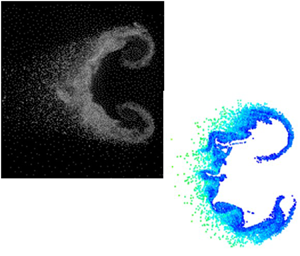Crossref Citations
This article has been cited by the following publications. This list is generated based on data provided by
Crossref.
Meng, Qingyang
Zhao, Ningbo
and
Zhang, Huangwei
2021.
On the distributions of fuel droplets and in situ vapor in rotating detonation combustion with prevaporized n-heptane sprays.
Physics of Fluids,
Vol. 33,
Issue. 4,
Xu, Yong
and
Zhang, Huangwei
2022.
Interactions between a propagating detonation wave and circular water cloud in hydrogen/air mixture.
Combustion and Flame,
Vol. 245,
Issue. ,
p.
112369.
Li, Jiarui
Xue, Kun
Zeng, Junsheng
Tian, Baolin
and
Guo, Xiaohu
2022.
Shock-induced interfacial instabilities of granular media.
Journal of Fluid Mechanics,
Vol. 930,
Issue. ,
Boyd, Bradley
and
Ling, Yue
2022.
A Consistent Volume-of-Fluid Approach for Direct Numerical Simulation of the Aerodynamic Breakup of a Vaporizing Drop.
SSRN Electronic Journal ,
Redding, Jeremy P.
and
Khare, Prashant
2022.
A computational study on shock induced deformation, fragmentation and vaporization of volatile liquid fuel droplets.
International Journal of Heat and Mass Transfer,
Vol. 184,
Issue. ,
p.
122345.
Hoeper, Matthew W.
Webb, Austin M.
Athmanathan, Venkat
Wang, Robert B.
Douglas Perkins, H.
Roy, Sukesh
Meyer, Terrence R.
and
Fugger, Christopher A.
2023.
Liquid fuel refill dynamics in a rotating detonation combustor using megahertz planar laser-induced fluorescence.
Proceedings of the Combustion Institute,
Vol. 39,
Issue. 3,
p.
3051.
2023.
Heat transfer effects on multiphase Richtmyer–Meshkov instability of dense gas–particle flow.
Physics of Fluids,
Vol. 35,
Issue. 5,
Zargarnezhad, H.
Myers, R.J.
Speck, A.K.
and
McFarland, J.A.
2023.
Radiation driven-dust hydrodynamics in late-phase AGB stars.
Astronomy and Computing,
Vol. 45,
Issue. ,
p.
100766.
Briney, Sam
and
Balachandar, S.
2023.
Euler–Lagrange stochastic modeling of droplet breakup and impact in supersonic flight.
Physics of Fluids,
Vol. 35,
Issue. 1,
Duke-Walker, Vasco
Musick, Benjamin J.
and
McFarland, Jacob A.
2023.
Experiments on the breakup and evaporation of small droplets at high Weber number.
International Journal of Multiphase Flow,
Vol. 161,
Issue. ,
p.
104389.
Musick, Benjamin J.
Paudel, Manoj
Ramaprabhu, Praveen K.
and
McFarland, Jacob A.
2023.
Numerical simulations of droplet evaporation and breakup effects on heterogeneous detonations.
Combustion and Flame,
Vol. 257,
Issue. ,
p.
113035.
Boyd, Bradley
and
Ling, Yue
2023.
A consistent volume-of-fluid approach for direct numerical simulation of the aerodynamic breakup of a vaporizing drop.
Computers & Fluids,
Vol. 254,
Issue. ,
p.
105807.
Young, Calvin
Musick, Benjamin
and
McFarland, Jacob
2023.
Investigations in Multiphase Detonations.
Xu, Yong
Li, Shangpeng
Meng, Qingyang
Zhang, Jungtang
and
Zhang, Huangwei
2024.
Direct initiation of hydrogen detonation in fine water sprays.
Physics of Fluids,
Vol. 36,
Issue. 8,
Si, Yingming
Li, Shuai
Meng, Baoqing
Wang, Chun
and
Tian, Baolin
2024.
A dominant dimensionless number and theoretical model for the evolution of multiphase Richtmyer–Meshkov instability.
Physics of Fluids,
Vol. 36,
Issue. 1,
He, Yifeng
Meng, Baoqing
Tian, Baolin
and
Yang, Yue
2024.
Shock-induced instability of dual-layer dilute gas-particle mixture.
Physical Review Fluids,
Vol. 9,
Issue. 12,
Jiao, Yu
Schmidt, Steffen J.
and
Adams, Nikolaus A.
2024.
Simulating shock interaction with a cavity-embedded cylinder/droplet using a real-fluid hybrid scheme at near-critical conditions.
Physical Review Fluids,
Vol. 9,
Issue. 7,
Wang, Wenhao
Yang, Miao
Hu, Zongmin
and
Zhang, Peng
2024.
A dynamic droplet breakup model for Eulerian-Lagrangian simulation of liquid-fueled detonation.
Aerospace Science and Technology,
Vol. 151,
Issue. ,
p.
109271.
Raj, Bebhash S.
and
Chandy, Abhilash J.
2024.
Numerical Simulations of Polymer Devolatilization in a Steam Contactor: Correlating Particle Distribution With Volatile Content Removal.
Journal of Thermal Science and Engineering Applications,
Vol. 16,
Issue. 12,
Duke-Walker, Vasco
and
McFarland, Jacob A.
2024.
Vorticity suppression by multiphase effects in shock-driven variable density mixing.
International Journal of Multiphase Flow,
Vol. 178,
Issue. ,
p.
104889.



